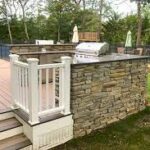
Wood is a delicate material actually, when handled correctly, it’s a beautiful and durable construction material but if not, it turns into a hassle liable to damage from nature and termite attacks.
Of the dangers to the structural strength of wood, water is the most potent, this is because water exposure can cause wood dampness, wood rot, or make it weaker to termite attack and paint. This is mainly because wood is extremely porous, which means that water will permeate the wood and if this happens continuously, the wood will rot or soften or even fall apart.
Today we would be exploring what exactly happens to wood when it gets wet and what can be done about it.
Effects of Water on Various Types of Wood

Various types of wood are used for a wide range of purposes, and due to the difference in their individual structures, they have different issues when exposed to water for extended periods of time. Some are more liable than others to have damage, let’s explore them in full:
Hardwood
.

Hardwood is mostly used for floors in homes as their durability is quite high, but if exposed to water for too long, the floors can start to buckle, they will also develop stains that are extremely hard to wash off and if the wood is used for countertops, it can develop wood rot in the sink area.
Softwood

Softwood has similar features to softwood when it comes to strength but the major difference is that hardwood is much more resistant to mold than softwood.
If softwood gets wet, stains, discoloration, and wood rot are bound to follow, however, the wood can be dried out if the damage or water exposure is identified early enough.
Particle Board
This is one of the most porous types of wood and as such is extremely susceptible to water damage, in fact, particleboard is the worst type of wood when it comes to wood damage and resisting water exposure.
You won’t have to deal with that situation as particleboard is mostly used for furniture but bear in mind that should particleboard ever get water damage, it will rot and break down and nothing can be done to save it.
MDF
Similar to particleboard, this is another type of wood that is weak to water damage. Just like particleboard it is made from wood chips and is therefore very porous. However, a solution is at hand as MDF can be made water-resistant with a layer of melamine.
Without this, MDF is worse than particle board of the water damage and woot rot. The damage that MDF can sustain is extremely much. Once the MDF is damaged, it’s irreversible.
Plywood
Plywood suffers the same types of damage that affect particle board when it is exposed to long-term water damage. If this type of wood goes wet, it becomes swollen and absorbs moisture. However, unlike particle broad, it can be saved by frying the wood out and saving extensive damage, but this is only applied if wood rot hasn’t set in. This can be checked by assessing if the layers have been separated, if they have not, they can be dried out, sanded, and refinished.
Osb
OSB
Last but definitely not least on this list, Osb is better resistant to water damage than particleboard and MDF but eventually, long-term damage would still spoil and damage it. The structure will deform and swell up if the water damage sets in but most times, Osb is quite water-resistant. But never leave it out in rain for a long time.
.
How to Clean Water from floors
When water touches your wooden floors, it’s very foolish to leave it there, if not the water could seep in and in the very near future constitute wood rot. Read below for steps and tips on handling water sills on the floor.
1. Wipe it.
No matter the size of the spill, never leave it standing, even if it does not rot the floor, it can cause stains on the wood. Make use of your towels or a dry rage to mop up the water.
2. Remove the soaked objects from the floor.
Remove carpets or wet furnishing from the floor to avoid the moisture in it seeping into the floor which can lead to mildew or mold in just over 24 hours.
3. Clean it up.
Cleaning the floor thoroughly, it’s very important to do this so as to prevent further damage to the floor. You can use a disinfectant, or a scrub brush to clean and wipe the floor, then use wood floor agents to remove the effects of the disinfectant.
Be aware though of the amount of water you use for this cleaning as too much water would do more harm than good. If you have issues understanding the right quantity to use, you can hire professional floor cleaners to do the work for you. They can also rehydrate and seal your floors against further damage.
4. Look out for mold.
Once cleaned, inspect for mold, mold is dangerous to floors and also your health, hence even if the floor is dry, make sure you have inspected it for spots with black, grey, or green speckles as these could be spore locations.







